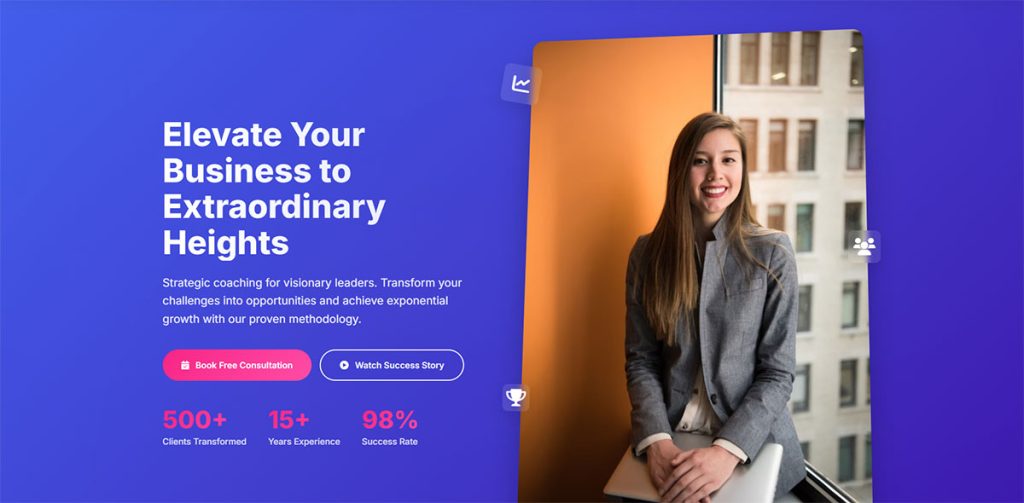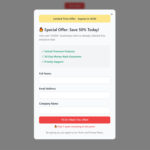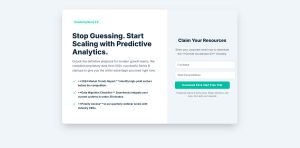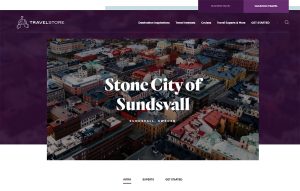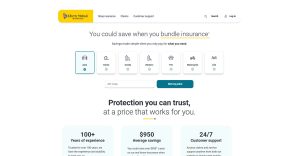Your website probably loses more subscribers than it gains. That’s the reality when your email signup sits ignored in the footer or buried on a contact page somewhere. Opt-in form…
Table of Contents
Your coaching expertise is solid, but your calendar stays empty.
The problem isn’t your skills. It’s that potential clients don’t know you exist, or they’re not ready to commit without experiencing your value first. Lead magnets for coaches solve this by offering free, high-value resources that attract your ideal clients and start building trust before they ever book a call.
Think downloadable workbooks, assessment quizzes, or free discovery sessions. These client attraction tools turn website visitors into email subscribers and subscribers into paying clients.
This guide breaks down 15 proven lead magnet formats that actually convert. You’ll discover which types work best for your coaching niche, how to create them efficiently, and how each one naturally leads prospects into your paid programs.
No generic theory here. Just practical formats you can implement this week to start growing your email list and booking more clients.
Lead Magnets For Coaches
| Lead Magnet Type | Implementation Effort | Conversion Potential | Engagement Duration |
|---|---|---|---|
| Free consultation or discovery call | Time-intensive (1:1 scheduling required) | High (direct relationship building) | 30-60 minutes per prospect |
| Downloadable workbook or worksheet | Moderate (design and content creation) | Medium (self-directed interaction) | 15-45 minutes (single use) |
| Email course or challenge | High (multi-day sequence setup) | High (sustained engagement) | 5-14 days (recurring touchpoints) |
| Assessment or quiz | Moderate (logic and result framework) | High (personalized insights) | 5-10 minutes (immediate results) |
| Cheat sheet or checklist | Low (quick reference format) | Medium (practical utility) | 2-5 minutes (reference material) |
| Video training or webinar | High (production and hosting setup) | High (instructor presence) | 30-90 minutes (passive viewing) |
| Resource guide or toolkit | Moderate (curation and organization) | Medium (value aggregation) | Ongoing (bookmark reference) |
| Template or swipe file | Moderate (format and example creation) | Medium (implementation support) | 10-30 minutes (customization time) |
| Mini course | High (structured curriculum design) | High (comprehensive learning) | 2-5 hours (module completion) |
| Case study or success story | Moderate (client documentation) | High (social proof delivery) | 10-20 minutes (narrative reading) |
| Goal-setting planner | Low (framework and prompts) | Medium (self-reflection tool) | 20-40 minutes (planning session) |
| Exclusive podcast episode | Moderate (recording and editing) | Low-Medium (passive consumption) | 20-60 minutes (audio listening) |
| Private community access | High (moderation and management) | High (network effect) | Ongoing (community participation) |
| Free trial of paid program | Low (existing program access) | Very High (product experience) | 7-14 days (trial period) |
| eBook or guide | High (comprehensive writing) | Medium (information density) | 1-3 hours (complete reading) |
Free Consultation or Discovery Call
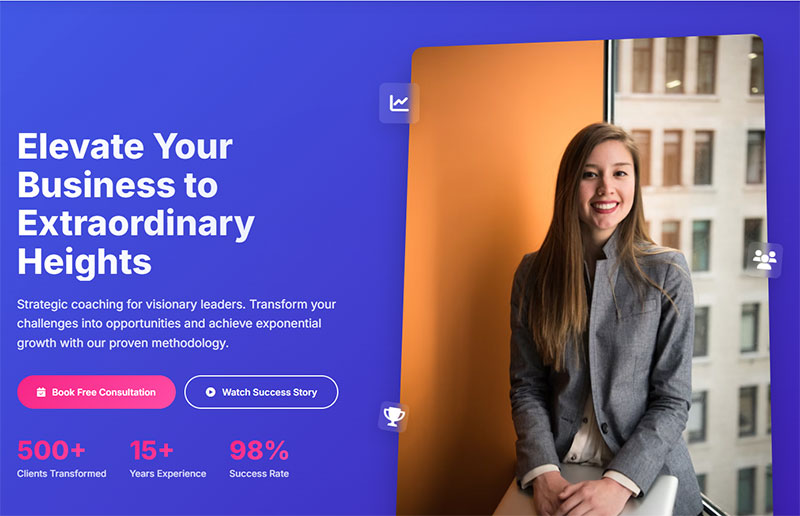
Your most direct path to converting cold prospects into paying clients.
This personal touchpoint lets potential clients experience your coaching style firsthand while you assess whether you’re a mutual fit.
Target Coaching Niche
Works across all coaching specialties, but especially powerful for business coaches, executive coaches, and life coaches selling high-ticket programs ($2,000+).
Ideal when trust-building is non-negotiable before someone commits.
Core Problem It Solves
Removes the biggest barrier to hiring a coach: uncertainty.
Prospects wonder if your style matches their needs. They’re scared of wasting money on the wrong coach. A conversation eliminates that fear faster than any PDF ever could.
Format & Delivery
15-30 minute Zoom or phone call scheduled through Calendly or similar booking software.
Delivered immediately via automated calendar link after prospect opts in.
Content Components
- Situation assessment (where are they now)
- Goal clarification (where do they want to be)
- Gap analysis (what’s blocking them)
- Your methodology preview
- Clear next steps (with or without selling)
Implementation Difficulty
For the coach: Medium. Requires carved-out calendar time and strong conversational skills.
For the client: Low. Just show up and talk.
Most coaches struggle with boundaries here (giving away too much coaching for free versus leaving people wanting more).
Conversion Mechanism
The call itself IS the conversion moment.
You’re demonstrating value in real-time. By the end, qualified prospects naturally ask about working together.
Research shows free consultations convert at higher rates than any other lead magnet when positioned as “strategy sessions” rather than sales calls.
Creation Time & Resources
Time: 2-3 hours for initial setup (booking page, confirmation emails, call framework).
Tools: Amelia or Trafft ($10-15/month), Zoom (free-$15/month), email automation through ConvertKit or similar.
Ongoing: 15-30 minutes per call, plus follow-up.
Downloadable Workbook or Worksheet
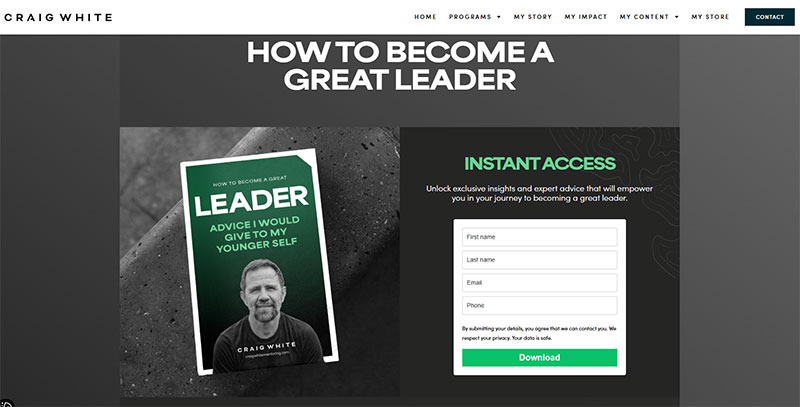
Image source: craigwhitecoaching.com
The workhorse of coaching lead magnets.
Simple to create, easy to consume, instantly actionable.
Target Coaching Niche
Universal appeal, but crushes it for productivity coaches, career coaches, relationship coaches, and anyone teaching a systematic process.
Life coaches use these for goal-setting exercises. Business coaches deploy them for strategy planning.
Core Problem It Solves
Gives prospects a structured way to think through their problems without hiring you yet.
They get a “quick win” that builds confidence in your methodology.
The workbook demonstrates you understand their specific challenges because you’ve created a framework to solve them.
Format & Delivery
PDF download (3-10 pages typically).
Automated delivery via email immediately after signup through your lead capture forms.
Content Components
- Clear instructions
- Fillable sections or prompts
- Reflection questions
- Action steps
- Bonus: scoring rubric or self-assessment
Best workbooks guide users through one complete micro-transformation (like “clarity on your next career move” or “your 90-day business roadmap”).
Implementation Difficulty
Creation: Low to medium. Most coaches already have frameworks they use with clients.
Client completion: Medium. About 40-60% will actually complete it (which is fine, that’s your qualifier).
Conversion Mechanism
Your follow-up email sequence references their workbook results and naturally transitions to “ready for the full transformation?” The workbook proves your process works, making the paid offer feel like the logical next step.
Creation Time & Resources
Time: 4-8 hours (3 hours for content, 2 hours for design, 1-3 hours for email setup).
Tools: Canva (free or $13/month for Pro), Google Docs for drafting.
Pro tip: Most coaches overthink this. A well-formatted Google Doc exported as PDF works better than an over-designed piece that took three weeks to create.
Email Course or Challenge
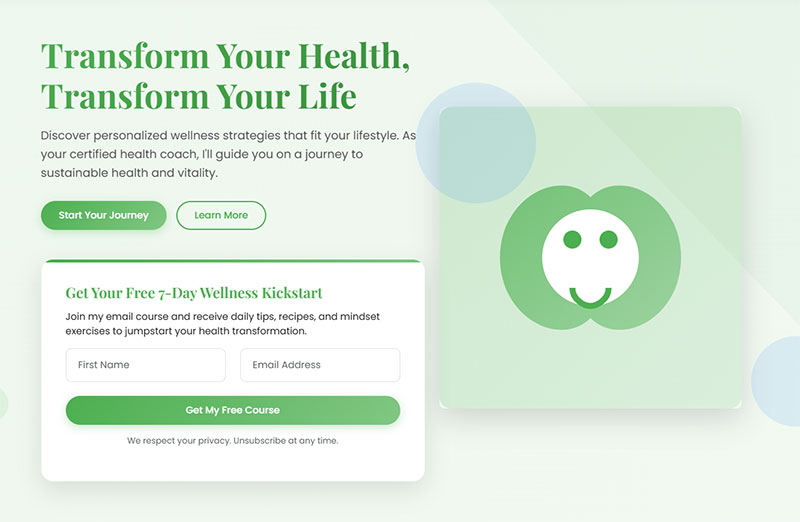
Automated teaching delivered to inboxes over 5-7 days.
Builds relationship momentum while educating prospects about your approach.
Target Coaching Niche
Health coaches, financial coaches, mindset coaches, and any niche where behavior change requires multiple touchpoints.
Works when your coaching outcome needs explanation or when trust-building takes time.
Core Problem It Solves
Combats information overwhelm.
Instead of dumping everything into one PDF, you drip valuable insights over several days. Each email builds on the last, creating a narrative that positions your paid program as the natural continuation.
Challenges add accountability through daily check-ins and action items.
Format & Delivery
5-7 automated emails sent daily or every other day.
Delivered through your email marketing platform using automated sequences. Each email should take under 5 minutes to read.
Content Components
- Day 1: Welcome + mindset shift
- Days 2-5: Teaching + action steps
- Day 6: Addressing objections or obstacles
- Day 7: Transformation recap + paid offer
Include skip-forward links so eager subscribers can get the next lesson immediately (boosts click rates by 13-43%).
Implementation Difficulty
Creation: Medium. Requires thoughtful sequencing and consistent voice across multiple emails.
Client experience: Low. Just check email daily.
The challenge format adds accountability but requires more participant engagement (only 30-50% finish).
Conversion Mechanism
By day 7, subscribers have spent a week thinking about their problem through your framework.
You’ve built trust through daily contact. The transition to your paid offer feels like continuing a conversation they’re already invested in, not a cold pitch.
According to data, marketers using email-based lead magnets see conversion rates 50% higher than those who don’t.
Creation Time & Resources
Time: 8-12 hours (1 hour per email for writing, 2-3 hours for sequence setup and testing).
Tools: ConvertKit, MailerLite, or Flodesk for email automation.
Can repurpose content from blog posts, client calls, or existing materials to speed up creation.
Assessment or Quiz
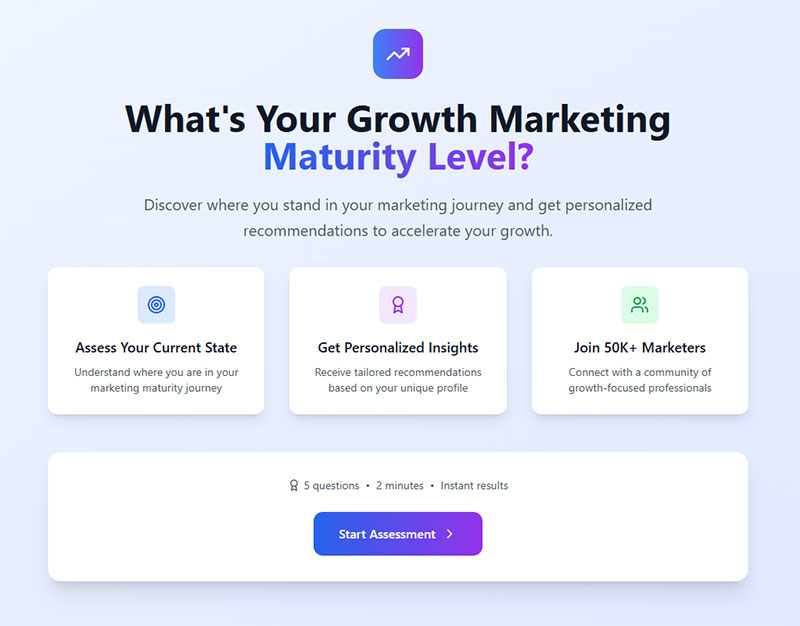
Interactive lead magnets with the highest engagement rates.
Personalized results make people feel seen in ways generic PDFs never will.
Target Coaching Niche
Career coaches (“What’s your ideal career path?”), relationship coaches (“What’s your communication style?”), business coaches (“What’s blocking your revenue growth?”).
Any niche where self-awareness or diagnosis precedes the solution.
Core Problem It Solves
Helps prospects identify their specific problem or personality type.
People love learning about themselves. Quizzes satisfy that curiosity while segmenting your leads based on their results (so you can send targeted follow-up).
The format pre-qualifies leads because completing a quiz requires more effort than downloading a PDF.
Format & Delivery
5-10 questions delivered through quiz software like Typeform, involve.me, or Outgrow.
Results delivered immediately on-screen plus via email (that’s your opt-in moment).
Content Components
- 5-10 multiple choice questions
- 3-5 result categories
- Personalized insights for each category
- Specific next steps based on results
- Email follow-up tailored to their quiz outcome
Implementation Difficulty
Creation: Medium to high. Requires logic mapping (which answers lead to which results).
Client experience: Low. Takes 2-3 minutes to complete.
Technical setup is the main hurdle, but tools like Typeform make it manageable.
Conversion Mechanism
Personalized results create an “aha moment” that positions your coaching as the solution to their newly-diagnosed challenge.
Segmented follow-up emails speak directly to their quiz category, making your pitch hyper-relevant. One coaching couple saw a 400% increase in subscribers and 38.8% conversion rate after adding a quiz.
Creation Time & Resources
Time: 6-10 hours (3 hours for question development, 3 hours for result writing, 2-4 hours for technical setup).
Tools: Typeform ($25-70/month), involve.me, or Outgrow. Integration with email platform required.
Cheat Sheet or Checklist
No-fluff, scannable action items.
The easiest lead magnet to create and the fastest for prospects to consume.
Target Coaching Niche
Productivity coaches, health coaches, business coaches, anyone teaching processes or systems.
Brilliant for coaches targeting busy professionals who want immediate value without wading through theory.
Core Problem It Solves
Decision fatigue and information overload.
Your prospects are drowning in advice. A checklist cuts through the noise with “just do these 7 things in this order.”
Removes thinking from the equation. Just follow the steps.
Format & Delivery
One-page PDF or Notion template.
Automated email delivery. Bonus points if it’s printable (people love physical checklists on their desk).
Content Components
- 5-15 specific action items
- Checkboxes or numbering
- Optional: brief context for each item
- No fluff, just action steps
Best checklists solve one specific micro-problem: “5-Minute Morning Routine,” “Client Onboarding Steps,” “Pre-Launch Checklist.”
Implementation Difficulty
Creation: Very low. Can create in 1-2 hours start to finish.
Client experience: Very low. Scan it in 60 seconds, use it immediately.
Conversion Mechanism
The checklist demonstrates you can simplify complex problems.
When prospects complete it and see results, they wonder “what else does this coach know?” Your follow-up emails position your paid coaching as the complete system the checklist came from.
Simple doesn’t mean weak. Some coaches report checklists outperform their elaborate guides.
Creation Time & Resources
Time: 1-3 hours (30 minutes to brainstorm, 30-60 minutes to write, 30 minutes to design).
Tools: Canva or Google Docs. That’s it.
Many successful coaches created their best-performing checklist in under an hour.
Video Training or Webinar
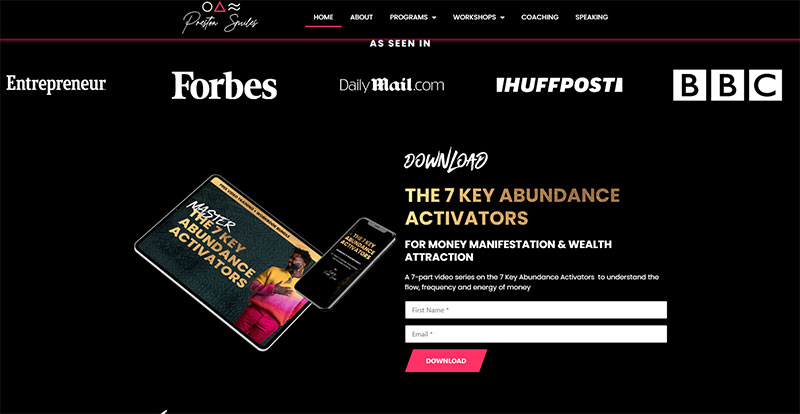
Image source: prestonsmiles.com
Face-to-face teaching builds trust faster than text ever could.
Research shows video lead magnets achieve the highest conversion rate at 24.2%.
Target Coaching Niche
Business coaches, mindset coaches, financial advisors, anyone selling high-ticket coaching where seeing your face and hearing your voice accelerates trust.
Webinars particularly excel when launching new programs.
Core Problem It Solves
“Is this coach legit?” doubt.
Video lets prospects assess your expertise, personality, and teaching style before committing. They’re essentially test-driving your coaching method.
Webinars also create urgency (live events) and community (real-time Q&A).
Format & Delivery
Pre-recorded training: 15-30 minute video hosted on YouTube, Vimeo, or your website.
Live webinar: 45-90 minutes via Zoom.
Delivered through dedicated landing page with webinar registration forms.
Content Components
- Hook (the promise or transformation)
- Teaching content (the “what” and some “why”)
- Proof (testimonials, case studies, your story)
- Soft or hard pitch for paid offer
- Q&A (for live webinars)
Best webinars follow the “teach-tease-sell” structure. Share enough to create wins, but position your program as the complete solution.
Implementation Difficulty
Creation: Medium to high. Requires scripting, recording/performing, editing.
Client experience: Medium. Requires 15-90 minutes of attention.
Live webinars are higher effort (you’re there in real-time) but often convert better. Pre-recorded videos scale better.
Conversion Mechanism
By the end, attendees have spent significant time with you. The pitch feels natural because you’ve already delivered value.
Landing page conversion rates for webinars can exceed 50%. Over half of marketers say webinar leads are “above average” quality.
Creation Time & Resources
Time:
- Pre-recorded: 8-15 hours (scripting, recording, editing)
- Live webinar: 5-8 hours prep, then 60-90 minutes per event
Tools: Zoom ($15/month), Vimeo ($7-75/month), Canva for slides, basic editing software (iMovie free, Descript $12-24/month).
Resource Guide or Toolkit
Curated collections of tools, templates, or resources.
Saves prospects hours of research while positioning you as the knowledgeable insider.
Target Coaching Niche
Business coaches, marketing coaches, productivity coaches, career coaches.
Any niche where your audience juggles multiple tools or systems.
Core Problem It Solves
Research paralysis.
Your prospects waste time Googling “best project management tool” or “how to automate client onboarding.” You’ve already tested everything and know what works. Share those insights.
Demonstrates you’re in the trenches, not just theorizing.
Format & Delivery
PDF guide or Notion page with links and descriptions.
Organized by category (software, templates, learning resources, etc.).
Content Components
- Tool/resource name
- What it does (2-3 sentences)
- Why you recommend it
- Link to access
- Optional: screenshots or video walkthrough
- Pro tip: tier recommendations (free, budget, premium)
Bonus: Include affiliate links (disclosed) to create revenue from the lead magnet itself.
Implementation Difficulty
Creation: Low to medium. You already use these tools, just document them.
Client experience: Low. Scan, bookmark, reference as needed.
Conversion Mechanism
Recipients use your recommended tools and see results.
You become their trusted advisor. When they need deeper strategy or implementation help, you’re the obvious choice.
Follow-up emails can spotlight different tools from the guide with case studies of how your clients use them.
Creation Time & Resources
Time: 4-6 hours (2 hours to list and describe, 2 hours to organize and design, 1-2 hours for setup).
Tools: Canva for PDF, Notion for interactive guide, Google Docs.
Template or Swipe File
Done-for-you resources people can customize immediately.
Templates eliminate blank-page paralysis and speed up results.
Target Coaching Niche
Business coaches, marketing coaches, sales coaches, content coaches.
Anyone teaching communication, strategy, or creative work.
Core Problem It Solves
The “I don’t know where to start” problem.
Templates give prospects the structure (you’ve solved the hard part). They just customize with their specifics.
Swipe files show proven examples they can model, removing the guesswork.
Format & Delivery
Editable files (Google Docs, Sheets, Canva templates, Notion pages) or PDF examples.
Access granted via email link after opt-in.
Content Components
Depends on type:
- Email templates: subject lines, body copy structure
- Strategy templates: frameworks with fillable sections
- Content templates: post outlines, video scripts
- Visual templates: Canva designs with edit access
Best templates include brief usage instructions.
Implementation Difficulty
Creation: Medium. Requires packaging your internal templates into user-friendly formats.
Client experience: Low to medium. Edit to their needs and use immediately.
Conversion Mechanism
When prospects use your template and get results (landed a client, wrote better content, closed a deal), they attribute success to your method.
They’re already “inside your system.” Upgrading to your paid coaching becomes the natural next step for advanced support.
Creation Time & Resources
Time: 3-6 hours (most time spent cleaning up your internal templates for public use).
Tools: Google Workspace (free), Canva ($13/month for branded templates), Notion (free-$10/month).
Mini Course
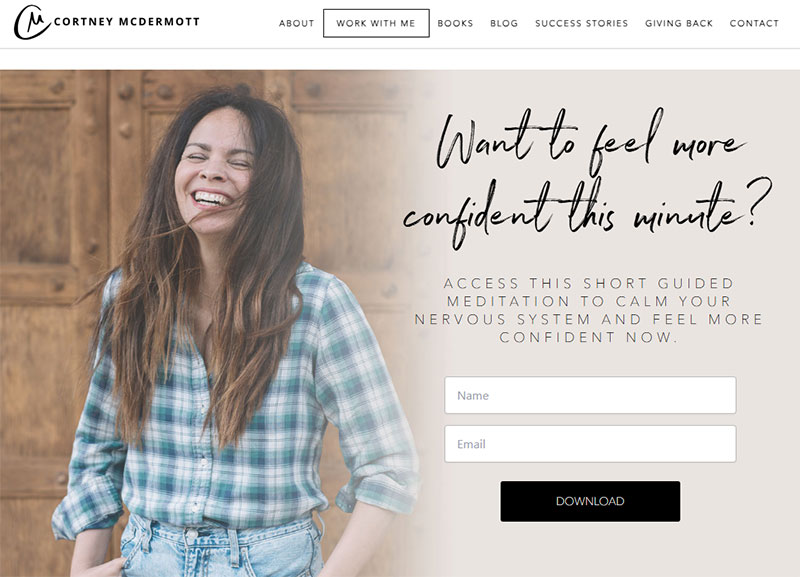
Image source: cortneymcdermott.com
A condensed version of your full coaching program.
Shows the breadth of your expertise while leaving the “juicy parts” gated behind your paid offer.
Target Coaching Niche
All coaching niches benefit, especially business coaches, marketing coaches, health coaches.
Perfect when your methodology has clear steps prospects need to understand before committing.
Core Problem It Solves
“What exactly will I learn?” uncertainty.
Mini courses give prospects a preview of your teaching style, content depth, and transformation process. They experience the coaching before buying it.
Also filters out tire-kickers. People who complete multi-part courses are serious prospects.
Format & Delivery
3-7 lessons delivered as:
- Automated email sequence
- Private course platform (Teachable, Kajabi)
- Private YouTube playlist
- Combination of video + PDF
Content Components
- Welcome video or email
- 3-5 teaching modules (video, audio, or written)
- Action steps for each module
- Workbook or worksheets (optional)
- Conclusion with pitch for full program
Can repurpose content from existing paid programs. Just share the framework, not the detailed implementation.
Implementation Difficulty
Creation: High. Most time-intensive lead magnet option.
Client experience: Medium to high. Requires commitment to complete multiple lessons.
Completion rates typically 30-50%, but completers are highly qualified leads.
Conversion Mechanism
Completers have invested hours learning your system. They’ve seen results from the preview version.
Your paid program becomes the obvious way to get the complete transformation. Mini courses often lead directly to high-ticket sales ($1,000-5,000+) because trust is deeply established.
Creation Time & Resources
Time: 15-30 hours (planning, content creation, recording, platform setup).
Tools: Kajabi ($55-149/month), Teachable (free-$119/month), or YouTube (free) + email automation.
Note: Many coaches repurpose existing client materials to cut creation time to 8-12 hours.
Case Study or Success Story

Image source: momonpurpose.com
Social proof as lead magnet.
Shows transformation is possible and demonstrates your methodology in action.
Target Coaching Niche
Business coaches, career coaches, health coaches, executive coaches.
Essential for any niche where prospects are skeptical about whether coaching “really works.”
Core Problem It Solves
The believability gap.
Prospects think “that sounds nice, but will it work for someone like me?” Case studies answer with concrete proof.
Stories are more persuasive than promises. Specific numbers, timelines, and obstacles overcome make transformation tangible.
Format & Delivery
PDF document (3-5 pages) or video interview with client.
Some coaches create entire libraries of case studies covering different client types.
Content Components
- Client background and starting point
- Specific challenge or goal
- Your coaching process/methodology applied
- Tangible results (numbers, timeframes)
- Client quotes (authenticity matters)
- Photos or screenshots (if relevant)
Structure: Before – Process – After
Implementation Difficulty
Creation: Medium. Requires client permission, interview time, writing/editing.
Client experience: Low. Just read the story.
Challenge: Getting client buy-in for sharing their story (offer incentives or anonymize if needed).
Conversion Mechanism
Prospects see themselves in the client’s journey.
If the featured client’s starting point matches where your prospect is now, the case study proves your coaching can work for them too.
Follow-up emails can share multiple case studies matching different prospect profiles.
Creation Time & Resources
Time: 6-10 hours per case study (client interview, drafting, design, approval process).
Tools: Canva for PDF design, Zoom for video interviews, basic editing software.
Pro tip: Create 3-5 case studies covering your main client types, then rotate them as lead magnets.
Goal-Setting Planner
Structured planning tools for achieving specific outcomes.
Combines aspiration with action in a format people revisit repeatedly.
Target Coaching Niche
Life coaches, career coaches, business coaches, financial coaches.
Anyone helping clients with long-term transformation or goal achievement.
Core Problem It Solves
Vague aspirations without action plans.
People know what they want but don’t know how to break it down into achievable steps. Your planner provides the framework for turning dreams into deadlines.
Fillable planners create ongoing engagement (they’ll use it for weeks or months).
Format & Delivery
PDF workbook (10-30 pages) or editable Google Doc/Notion template.
Can be monthly, quarterly, or annual planners depending on your niche.
Content Components
- Vision/goal clarification exercises
- Goal breakdown (annual – quarterly – monthly – weekly)
- Habit tracking pages
- Reflection prompts
- Progress review sections
- Obstacle troubleshooting frameworks
Best planners balance inspiration (vision work) with execution (specific action steps).
Implementation Difficulty
Creation: Medium. Requires thoughtful structure and appealing design.
Client experience: Medium. Filling it out takes 30-90 minutes initially, then ongoing updates.
Conversion Mechanism
Users spend weeks or months working with your planner.
Your framework becomes their daily success tool. When they hit obstacles or want accountability, your coaching is the natural escalation.
Follow-up emails can reference typical planning milestones: “It’s been 30 days since you downloaded the planner. How’s progress?”
Creation Time & Resources
Time: 10-15 hours (framework development, page design, testing).
Tools: Canva, Google Docs, or specialized tools like Notion.
Exclusive Podcast Episode
Audio content for busy prospects who prefer listening over reading.
Creates intimacy through voice while allowing consumption during commutes or workouts.
Target Coaching Niche
All niches, but particularly effective for business coaches, mindset coaches, personal development coaches.
Great when targeting busy professionals who overconsume podcasts already.
Core Problem It Solves
Content consumption friction.
Many prospects won’t read a 10-page PDF, but they’ll gladly listen to a 20-minute episode while driving. You meet them in their preferred format.
“Exclusive” positioning makes it feel special compared to publicly available content.
Format & Delivery
Audio file (MP3) delivered via email link or private podcast feed.
20-40 minutes typically. Can be interview-style, solo teaching, or client success story.
Content Components
- Hook in first 60 seconds (what they’ll learn)
- Teaching or story
- Actionable takeaways
- Call-to-action for next step
- Brief mention of paid programs
Best episodes tackle one specific problem with a clear solution or framework.
Implementation Difficulty
Creation: Medium. Requires recording equipment and basic editing skills.
Client experience: Low. Just hit play.
Audio quality matters more than you think. Poor audio = unprofessional perception.
Conversion Mechanism
Voice creates connection faster than text.
Prospects feel like they “know” you after listening. The intimacy of audio in someone’s ears builds trust quickly.
Follow-up emails can reference specific moments from the episode, continuing the conversation.
Creation Time & Resources
Time: 4-8 hours (scripting, recording, editing, uploading).
Tools: Basic mic ($50-150), Audacity (free) or Descript ($12/month) for editing, hosting on Dropbox/Google Drive or proper podcast host.
Private Community Access
Temporary or permanent access to your coaching community space.
Leverages peer connection and ongoing engagement rather than one-time downloads.
Target Coaching Niche
Life coaches, business coaches, mastermind facilitators, group program coaches.
Works when community is a key differentiator of your coaching approach.
Core Problem It Solves
Isolation in the journey.
Prospects struggling alone discover others facing similar challenges. The community provides connection, accountability, and proof that transformation is happening for real people.
Access to you (even limited) in the community creates perceived high value.
Format & Delivery
Invitation to private Facebook group, Slack channel, Discord server, or Circle community.
Can be limited-time trial (14-30 days) or permanent but with limited features.
Content Components
- Welcome post introducing new members
- Resources section (pinned posts with key content)
- Discussion threads around common challenges
- Weekly prompts or challenges
- Limited access to you (weekly Q&A, for example)
Active moderation essential. Dead communities repel more than attract.
Implementation Difficulty
Creation: Low initially (set up platform). High ongoing (requires consistent engagement and moderation).
Client experience: Medium. Requires active participation to get value.
Challenge: Maintaining community vitality with free members who may not be as committed.
Conversion Mechanism
Members experience the support, connection, and your coaching style firsthand.
When you announce your paid program inside the community, conversions are high because trust is established. You’ve essentially created a trial run of your paid community coaching model.
Creation Time & Resources
Time: 3-5 hours setup, then 3-5 hours weekly for moderation.
Tools: Facebook Groups (free), Circle ($39-219/month), Slack (free-$8/month), Discord (free).
Free Trial of Paid Program
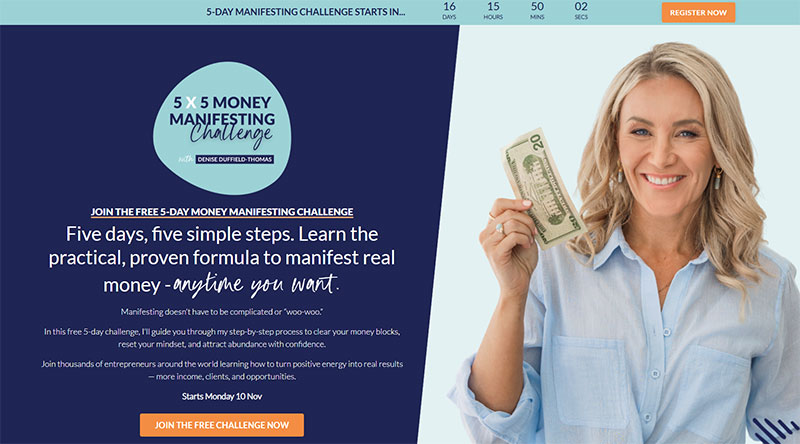
Image source: denisedt.com
The ultimate “try before you buy” approach.
Give limited access to your full coaching program rather than creating separate lead magnet content.
Target Coaching Niche
Online course coaches, group program coaches, membership-based coaches.
Works when your program has clear modular structure allowing trial access.
Core Problem It Solves
Purchase hesitation from not knowing if the program fits their learning style or solves their specific problem.
Trials remove risk. Prospects experience the quality, format, and value firsthand.
Format & Delivery
7-14 day access to first module or section of your paid program.
Delivered through your course platform (Kajabi, Teachable, Thinkific).
Content Components
- First 1-2 modules of full program
- Access to community (if included)
- Limited or full coaching access (your choice)
- Clear boundary of what’s included vs. what requires upgrade
Trial should create a “wow, I need more” feeling, not full satisfaction.
Implementation Difficulty
Creation: Low if program already exists. Just create trial access level.
Client experience: Medium. Requires engaging with actual course content.
Technical setup of trial periods and upgrade funnels requires platform knowledge.
Conversion Mechanism
Trial completers have already started the transformation journey.
They’ve invested time, seen initial results, and gotten comfortable with your platform. Upgrading feels like continuing momentum, not starting something new.
Trials typically convert 15-25% to paid within 30 days when properly nurtured.
Creation Time & Resources
Time: 2-4 hours (setting up access levels, automation, email sequences).
Tools: Your existing course platform. Most include trial access features.
Pro tip: Track which trial content users consume most to optimize your trial experience.
eBook or Guide
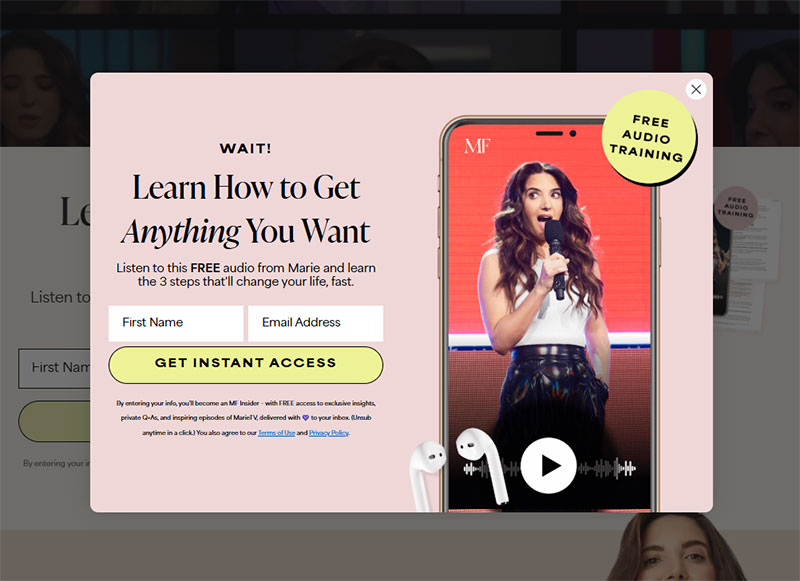
The classic lead magnet.
Comprehensive written resource that positions you as the authority while educating prospects deeply on one topic.
Target Coaching Niche
All coaching niches, but particularly business coaches, career coaches, relationship coaches.
Best when your methodology is complex enough to require explanation or when your ideal clients prefer reading over video.
Core Problem It Solves
Surface-level understanding of the problem without the full context needed to solve it.
eBooks provide the “why” behind your approach while offering frameworks prospects can reference repeatedly.
Also serves as a calling card. Recipients share quality eBooks with colleagues.
Format & Delivery
PDF download, typically 15-40 pages.
Automated delivery via email after form submission.
Content Components
- Cover page with compelling title
- Table of contents
- Introduction (the promise)
- 5-7 chapters covering key concepts
- Frameworks, diagrams, or models
- Case examples or stories
- Conclusion with call-to-action
- About the author page
Should look professionally designed but doesn’t need to be elaborate.
Implementation Difficulty
Creation: High. Most time-intensive to write and design.
Client experience: Medium. Reading 15-40 pages requires commitment.
Challenge: Many download but never read. Your follow-up emails must create reading incentive.
Conversion Mechanism
Readers invest hours consuming your content. By the end, they understand your methodology and see gaps in their current approach.
Your paid coaching becomes the implementation layer for what they learned in theory.
eBooks work best with strong email nurture sequence that references specific chapters and transitions naturally to paid offer.
Creation Time & Resources
Time: 20-40 hours (research, writing, editing, design, setup).
Tools: Google Docs for writing, Canva for design ($13/month), or hire designer ($200-800).
Many coaches report eBooks have lower conversion than simpler formats, but attract more serious, higher-ticket buyers.
FAQ on Lead Magnets For Coaches
What is a lead magnet for coaches?
A lead magnet is a free resource you offer in exchange for contact information, typically email addresses. Common formats include downloadable workbooks, assessment quizzes, cheat sheets, or free consultation offers.
The goal is attracting ideal clients while demonstrating your expertise before they commit to paid coaching.
How do I create my first lead magnet?
Pick one problem your ideal clients face right now. Create a simple solution they can implement quickly—a checklist, template, or one-page worksheet works perfectly.
Use Canva for design, set up automated delivery through ConvertKit or similar platforms, then promote it on your website using lead capture forms.
What’s the best lead magnet format for coaches?
Discovery calls convert highest for high-ticket coaching ($2,000+). For scalability, workbooks and assessments perform best.
Video training achieves 24.2% conversion rates according to research. Test what resonates with your specific coaching niche and audience preferences.
How long should a lead magnet take to create?
Simple checklists take 1-3 hours. Workbooks require 4-8 hours.
Mini courses demand 15-30 hours but generate more qualified leads. Start simple, then expand based on what converts best for your coaching business.
Do I need expensive tools to create lead magnets?
No. Google Docs, Canva’s free version, and basic email platforms like MailerLite work fine initially.
Invest in paid tools (ConvertKit, Calendly, Typeform) once you’re consistently converting subscribers into clients and have revenue to justify the expense.
How many lead magnets should I have?
Start with one focused on your core offer. Once that converts reliably, create 2-3 more targeting different client pain points or buyer journey stages.
Quality beats quantity. One excellent resource guide outperforms five mediocre PDFs every time.
What makes a lead magnet actually convert?
Solves one specific problem fast. Delivers immediate value without requiring your coaching program to implement.
Creates a quick win that builds trust in your methodology, then naturally positions your paid services as the next logical step through strategic email sequences.
How do I promote my lead magnet?
Add opt-in forms to your website using popup forms and inline forms. Share on social media platforms like Instagram, LinkedIn, and Facebook Groups.
Run targeted ads if budget allows. Guest podcast appearances where you mention your freebie work exceptionally well.
Should my lead magnet be gated or free?
Always gate it behind an email opt-in. That’s the entire point—exchanging value for contact information.
Gated content builds your email list, which remains your most valuable marketing asset. Free ungated content builds awareness but doesn’t capture leads.
How do I know if my lead magnet is working?
Track conversion rates (aim for 20-40% on landing pages), email open rates (35-50%), and ultimately how many subscribers book discovery calls or purchase programs.
If fewer than 10% engage with follow-up emails, your lead magnet likely attracts wrong-fit prospects or fails to deliver sufficient value.
Conclusion
The right lead magnets for coaches transform how you attract and convert clients. Stop waiting for referrals or hoping social media posts magically fill your calendar.
Choose one format from this guide that aligns with your coaching methodology and client needs. A simple worksheet often outperforms an elaborate eBook if it solves the right problem.
Set up your lead generation form this week. Connect it to an email automation sequence that nurtures subscribers toward your paid programs.
Track what converts. Double down on what works.
Your coaching business deserves a predictable client pipeline, not feast-or-famine months. Free consultation offers, assessment tools, and downloadable resources all work—but only when you actually launch them.
Start building your email list today. Your future clients are searching for solutions you already know how to provide.


